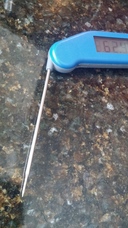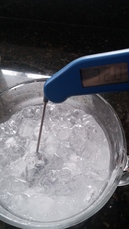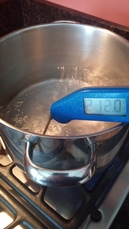02/01/2015
Vol. 19, Issue 1
Food Digest is a quarterly newsletter written by inspectors from your local health department to support and educate Hennepin County food facility owners and managers about food safety as recommended by Minnesota Food Code 4626.
Hennepin County will be offering a basic food safety class in March. Call 612-543-5200 to sign up.
We welcome comments or ideas about our newsletter.
Amy Zagar
612-543-5267
Hannah Marschinke
612-543-5255
|
 Hennepin County Public Health Protection is thrilled to welcome Mailee Moua!
Before joining Hennepin County Public Health Department in January 2015, Mailee worked at the City of Bloomington as an Environmental Health Aide. Mailee’s primary duties in Hennepin County include food, lodging, and pool inspections.
Mailee recently graduated from the University of Illinois at Chicago with her Master’s of Public Health in Environmental and Occupational Health and a concentration in Environmental Health Policy. While in graduate school she worked as a Research Assistant and spearheaded a graduate student alliance organization for Environmental Health. In her spare time, she enjoys outdoor biking, sports, and traveling to new cities and countries.
|
Have you ever taken a temperature of food, say
chicken wings, with two different thermometers only to find two very different
readings? According to the Partnership for Food Safety Education, Americans eat
an estimated billion chicken wings during the Super Bowl. Hopefully they will
all be cooked to 165° F using a calibrated food thermometer!
Proper internal food temperatures are critical
and must be accurately measured and monitored routinely to ensure food is
stored, cooked and cooled safely. Before using a food thermometer, read the
manufacturer's instructions. The instructions should verify how far the
thermometer must be inserted in a food to give an accurate reading.
Calibrations instructions should also be included. When it comes to cooking and
serving food to the public, food thermometers shall be provided, be in good
working order and be calibrated. (MN Food Code 4626.0820,
4626.0705)
There are many different
types of thermometers; accordingly they differ in the way they are used. Most
common thermometers are bimetallic stemmed thermometer, thermocouple or
thermistor, and infrared thermometer. Below are characteristics and tips for
using each thermometer:
Bimetallic Stemmed Thermometer
- Most common and versatile type of
thermometer used in a restaurant.
- Has an adjustable calibration nut to keep it
accurate; easy-to-read numbered temperature markings; a dimple to mark the end
of the sensing area; and accuracy.
- Measures the temperature of a food in about
15 to 20 seconds.
- To get an accurate temperature reading, the
entire sensing area (usually 2 to 3 inches) needs to be positioned through the
center of the food.

Thermocouple and Thermistor
- Measure temperatures through a metal probe
or sensing area and results are displayed on a digital readout.
- Very fast reading, within 2 to 5 seconds.
*Easy to check multiple areas of food item
- Thin probe makes it easy
to temp thin foods, such as hamburger patties and chicken breasts.
|
 Infrared Thermometer
- Used to measure surface temperatures only.
- Some are not very accurate, can be 3-5
degrees off.
- Not suitable for internal temperatures of a
food, therefore always verify internal temperatures of food with a calibrated
probe thermometer.
To be considered accurate, a thermometer must
be calibrated to measure within +/- 2° F (1° C) of the actual temperature (MN
Food Code 4626.0555). The easiest and most affordable way to
calibrate a thermometer is through using and ice bath or boiling water method.
|

Ice bath method
1. Fill a large container (2-quart container)
with crushed ice to the rim. Add just enough clean tap water to fill in cracks
of ice (approximately ½ inch below the rim).
2. Stir ice and let sit for one minute. Insert
thermometer stem or probe into the ice water so the sensing area is completely
submerged (over the dimple), about two inches and gently stir the probe. Wait
30 seconds or until the indicator stops moving.
3. If the temperature is at 32° F (0° C), then
remove the thermometer. It is ready for use.
4. If the temperature is
not at 32° F (0° C), then hold the calibration nut securely with a wrench or
other tool and rotate the head of the thermometer until it reads 32° F (0° C).
If it does not have a calibration nut, consult directions, have it
professionally serviced or discard thermometer.
|

Boiling-point method (This method can only be used if your
elevation is 1,000 feet or less. If you do not know your elevation, it is best
to check the accuracy of your thermometers using the ice-point method.)
1. Boil clean tap water in a deep pot (sauce
pan or stockpot) to a rolling boil.
2. Put the thermometer stem or probe into the
boiling water so the sensing area is completely submerged over the dimple.
3. Wait 30 seconds or until the indicator
stops moving. Do NOT let probe touch sides of pot.
4. If the temperature is at 212°F (100°C) then
remove the thermometer. It is ready for use.*
5. If the temperature is not at 212°F (100°C),
hold the calibration nut securely with a wrench or other tool and rotate the
head of the thermometer until it reads 212°F (100°C) or the appropriate
boiling-point temperature for your elevation. If it does not have a calibration
nut, consult directions, have it professionally serviced or discard
thermometer.
*Note: Altitude does alter
boiling temperatures. Check out WorldAtlas.com to determine the altitude of
your location and verify proper boiling point.
Back to top
|
SECTION 8: INDUSTRY SELF-SURVEY AND TRAINING RESPONSIBILITY.
8.1 Self-Inspection Program. Every licensee of a food establishment shall arrange for and maintain a program of sanitation self-inspection conducted by the owner, operator, or certified food manager and approved by the Health Authority. The self-inspection program shall include written policies, appropriate forms for logging self-inspections, and evidence that routine self-inspection of all aspects of the food establishment takes place. A description of the food establishment operation, including the menu, shall be available for review.
MN Departments of Agriculture and Health/APC food safety self-audit checklist
Hennepin County Ordinance 3
Back to top
Visit www.hennepin.us/envhealth for information on:
- General environmental health
- Basic food safety classes
- Temporary food stand licensing
- Food license information, categories, and fee schedule
- New construction or remodeling application
Radon information and test kits
www.hennepin.us/radon
Septic system requirements and procedures
www.hennepin.us/septic
Body art licensing information (tattooing and piercing)
www.hennepin.us/bodyart
Beaches in Hennepin County
www.hennepin.us/beaches
To sign up for Food Digest, please use the link provided below:
https://public.govdelivery.com/accounts/MNHENNE/subscriber/new?topic_id=MNHENNE_227
Back to top
|